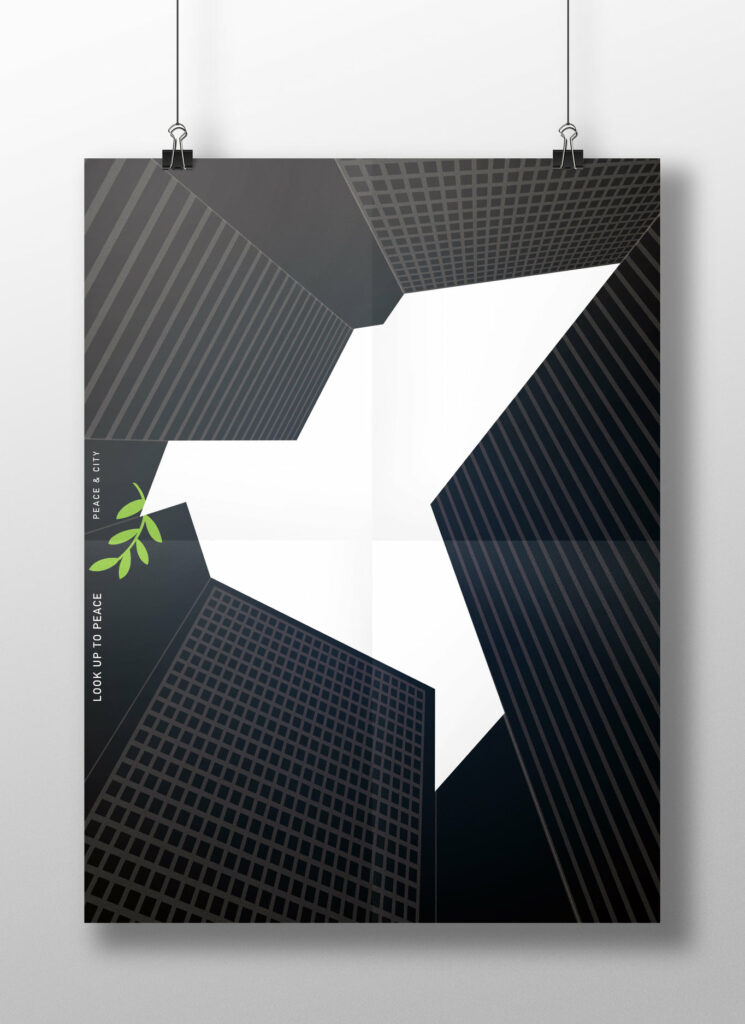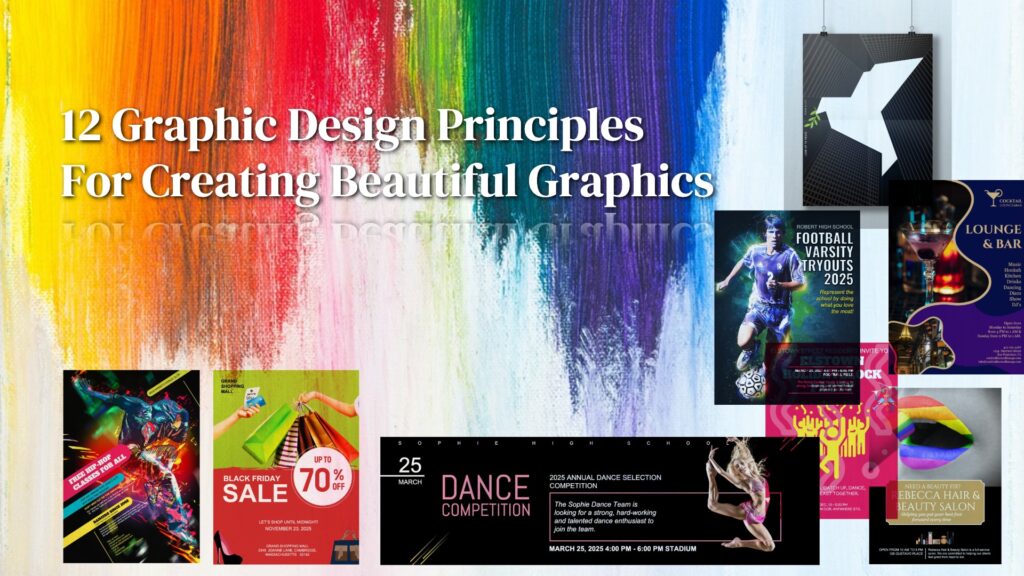To create effective and eye-catching graphics, you must follow the “graphic design principles.” Therefore, if you are a beginner or a 100% non-designer, then understanding and mastering “graphic design principles” will be the most important lesson for you to become a graphic designer.
In fact, there are many articles on “Principles of Graphic Design”. But for beginners, most of them have a steep learning curve. Therefore, this article will start with a number of related topics for a more detailed interpretation.
- The difference between graphic design and artistic creation.
- What are the principles of graphic design?

The difference between graphic design and artistic creation.
However, before discussing the principles of graphic design, take a moment to understand the difference between graphic design (especially commercial graphic design) and artistic creation. Because it will help to further learn the principles of graphic design.
Graphic design and artistic creation both convey themes through visual content. The difference is that in artistic creation, artists use professional skills and innovative ideas to make the work “resonate with readers”, so readers may need a certain degree of appreciation.
But graphic design not only needs to attract people’s attention but more importantly, it needs to allow everyone to quickly understand its theme and remember its purpose. Especially for commercial graphic design, if the subject is vague or there is no clear related purpose, it can be regarded as an invalid work. Because no one wants to pay for unmatched or irrelevant “fine pictures”.
To this end, experienced graphic design masters have summarized 12 graphic design principles to help all graphic creators.
What are the principles of graphic design?
Some of the most commonly recognized principles of graphic design are alignment, balance, contrast, proximity, repetition, and white space, harmony, emphasis, movement, rhythm, proportion, and unity.
Graphic design principles: What is “alignment”?
Alignment is the act of keeping design objects in a straight line. However, not only in the vertical or horizontal direction but also in any linear plane. They can be aligned as a whole or in blocks.

Graphic design principles: What is “balance”?
Balance is a complex concept based on perception. A balanced design should have a planned layout of elements and maintain a consistent visual style (including color, shape, and space).
The composition of perfect symmetry and linearity is not necessarily balanced. For example, the asymmetric or radial distribution of text and graphic elements can achieve a balanced composition. Even with a large area of blank space, all elements can find a sense of balance. Because humans can evaluate these visual elements on multiple levels to find a comfortable sense of balance.

Graphic design principles: What is “contrast”?
Contrast is an important principle of design, which is to intuitively guide and highlight themes by creating differences. Because it can help you point out the most important elements in the design and increase focus.
When two design elements face each other, the contrast appears. Contrast is a way to help guide the viewer’s eyes to see the most important part of the design and organize the information in it.
Create contrast between design elements, including the use of contrasting colors, sizes, shapes, positions, or relationships.
For text, you can get contrast by mixing serifs and sans serifs on the page, using very different font styles, styles, or using fonts in surprising or unusual ways.

Graphic design principles: What is “proximity”?
Closeness or distance of individual design elements. Close proximity indicates a connection. Proximity means grouping elements together so that you guide the viewer/reader to different parts of the message.

Graphic design principles: What is “repetition”?
Repeat a sequence to make it happen multiple times. In design, repetition can create visual consistency in page design, such as using the same style of headings, the same style of capital letters, or repeating the same basic layout between pages.
It should be noted that too much repetition (monotonous) may lead to boring and uninteresting composition. If for some reason you can’t avoid too much repetition, don’t forget to add some visual distractions and white space.

Graphic design principles: What is “white space (negative space)”?
White space (or negative space) is the area in the design where there is no text or graphics. In graphic design, white space or negative space is regarded as an important element of the entire design.
White space may increase or destroy the balance, unity, harmony, rhythm, and overall success rate of the design. In addition, the white space can make the emphasis, contrast, and sense of movement be reflected. It can be used for repetitions and patterns and can establish various relationships with other elements in the positive and negative spaces in the design.

Xuejun Song
Chief designer of Drawtify
Graphic design principles: What is “harmony”?
As with music, graphical elements can be said to be working in harmony – the individual parts come together as visually compelling and a meaningful whole. Disharmony can also be used just as it is in musical compositions: to enhance the emotional complexity, to challenge the viewer, and to give a contrast within the overall composition.

Graphic design principles: What is “emphasis”?
Make certain elements stand out or attract attention. By using other principles (such as contrast, repetition, or movement) and placing elements on the page where the eyes are drawn naturally, emphasis can be gained in graphic design. Bold and italics provide emphasis for the text. Graphic elements are emphasized by size, visual weight, color, complexity, uniqueness, placement on the page, and other functions.

Graphic design principles: What is “movement”?
An image with a motion effect will get a stronger visual effect. Movement can be achieved by using graphical elements that direct the eyes in a certain direction (for example, an arrow that clearly points forward) or a series of lines or points that gradually become larger or smaller, resulting in more subtle visual effects. Or, simply apply effects such as blur to photos or clip art of moving objects (objects fixed by runners instead of standing people) to achieve sports effects.

Graphic design principles: What is “rhythm”?
Rhythm refers to a strong and regular repetitive movement or sound pattern. The successful design has an effective ebb and flow. It seems that text and graphics should be arranged in rhythm and style. Spacing is an effective application of this principle. Second, humans are generally easier to adapt to change. Psychologically speaking, any serious lack of changes in anything (solid lines, lines, sounds, situations) can become very boring. As long as you don’t overdo it, adding a little change at non-specific intervals (from time to time) can make most designs interesting.
In the setting type, you can create or destroy the rhythm. The definition of rhythm is to suggest movement through the use of various elements.


Graphic design principles: What is “proportion”?
Proportion is the relationship between two or more elements in a design and how they compare.
When there is a correct relationship between the size or number of elements in a design, the constituent elements look as if they belong to the same category in size and distribution. This means that the specific graphic elements in the design combination have established a good relationship with each other (including relative visual size, width, and weight), and produced a sense of unity.

Graphic design principles: What is “unity”?
Unity is a sense of wholeness, which is usually achieved when the parts complement each other in the same way. Whether it is color or shape, this can be achieved by using complementary or identical (or similar) attributes. Even use similar graphic styles for illustration.

Graphic design is my passion!
Trying more is the only way to become a graphic designer. Therefore, if you are a beginner, you may need comprehensive and easy-to-use graphic design software. It is recommended to download Drawtify Designer immediately and start a free trial.
Of course, keeping in mind the principles of graphic design and using them proficiently will give you a huge help in your graphic design journey.
